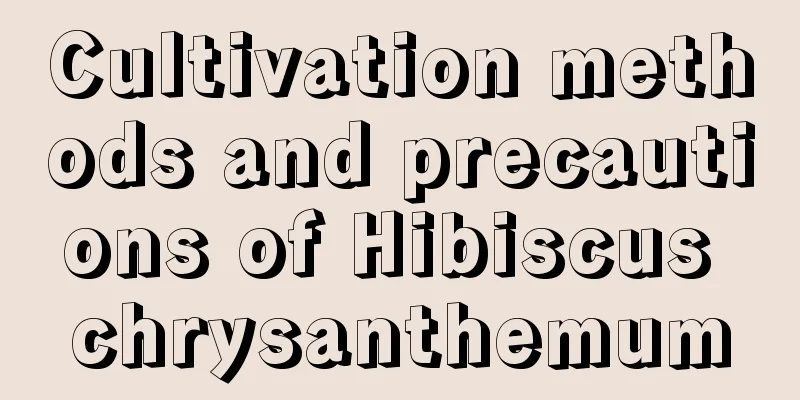Cultivation methods and precautions of Hibiscus chrysanthemum

1. SoilWhen breeding, the soil must be breathable and fertile. Only with good air permeability can the roots absorb nutrients well. You can mix leaf mold, river sand and garden soil in a ratio of 5:2:3. 2. LightingIt likes light very much and cannot grow normally without light. Usually it should be placed in a sunny place, but the afternoon light in summer is too strong, so it should be moved away in time to avoid burns. It can receive full sunlight at other times. If the light is not sufficient, it will easily grow weak. 3. WateringAlthough it likes a humid environment, it also has a certain degree of drought resistance. Therefore, it is best to water it when the soil is dry and keep it moist but not waterlogged, and water it thoroughly when watering. In addition, during the high temperatures in summer, you should spray water frequently to increase the humidity. You need to control water intake during winter when the temperature is low, otherwise you may get frostbite easily. 4. FertilizationDuring maintenance, you should apply fertilizer frequently and supplement nutrients. Because it has a well-developed root system, it needs a lot of nutrients to grow. Usually, fertilizer should be applied every ten days in spring and autumn. Either decomposed cake fertilizer or organic liquid fertilizer can be used. In addition, it should be applied once in autumn to improve cold resistance. 5. NotesWhen maintaining and managing the plant, be sure to change the pot and soil every two or three years, preferably in spring. Also, be careful not to damage the roots when removing the plant from the pot, otherwise it will affect its later growth. |
>>: Maintenance methods and precautions of sea daffodils
Recommend
Things to note when transplanting bougainvillea: transplanting methods and management matters
After growing for 2-3 years, the bougainvillea pl...
Rhododendron growth environment conditions and characteristics
Rhododendron growth environment conditions and re...
These "3 types" of water cannot be used casually to feed flowers, and most people don't know it yet
Huahua would like to remind everyone here not to ...
How to prune the vine after it blooms
Pruning after flowering The fragrant vine should ...
What are the advantages and disadvantages of red juice balcony roses? What kind of roses does it belong to?
Red Juice Balcony Rose, also known as Red Juice, ...
How much should I water the plum blossoms at a time? How to remedy overwatering the plum blossoms
1. How to water The plum blossom does not have a ...
When to plant carrots
Carrots are popular for their excellent adaptabil...
Ivy cultivation methods and precautions
1. Maintenance methods 1. Temperature: The temper...
When is the best time to harvest peanuts? (What month is the best time to harvest peanuts?)
Crops are something that makes people anxious whe...
What can dandelion be paired with to remove its coldness, and what can dandelion be paired with to not remove its coldness
1. Red dates and wolfberry Dandelion can be combi...
How to make Euphorbia obesa bloom more
In fact, the vigorous growth of Euphorbia obesa d...
Does Begonia need sunlight?
Need some sun? Begonia, like most plants, loves l...
The language and legend of geranium
The Flower Language of Geranium Geranium: An acci...
When is the best time to transplant Wisteria?
There are many ways to transplant wisteria, the m...
Yam planting technology and cultivation management
As a crop that prefers warmth and has a long grow...









